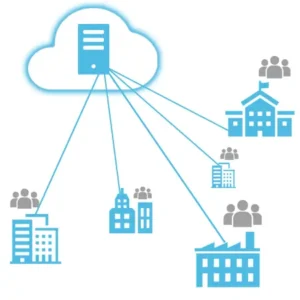What is Multi-Tenancy?
You may have come across the term “Multi-Tenancy” related to Information Technology. What exactly does it mean and what does it do?
Simply put, “Multi-Tenancy” is a term used to describe an architecture in which a single installation of software, or service, is used to deliver services to multiple, autonomous organizations. Each organization is referred to as a “tenant.”
If you picture what usually comes to mind when hearing the word “tenant,” someone who rents an apartment in a building, the comparison is not dissimilar.
Let’s consider the comparison for a moment. Imagine an apartment building and the tenants living within it. You have one large building, sub-divided into apartments. There are common areas like the front door, hallways, and perhaps laundry facilities. Electricity, gas, and water services are delivered to the building as a whole, and then sub delivered to each apartment.
Aside from the common areas, each tenant has their own private living space. Unless you invite your neighbor over, tenants cannot enter each other’s living spaces. At the same time though, they all make use of shared resources provided by the landlord, such as the utilities and other services. Rather than purchasing their own separate houses, tenants pay to use portions of pooled resources in the form of an apartment and all the other shared services that come with it.
So, how does this apply to Information Technology?

Deliver Virtualized App and Desktop Services
OVD Enterprise 2.7 introduces support for multi-tenant deployments.
As in the apartment building comparison, a single instance of OVD Enterprise can be used to deliver virtualized apps and desktops to multiple tenants. OVD is the equivalent to the apartment building in our previous example. In addition to the OVD server farm, other resources like file servers and directory services can be pooled together and shared.
Security Considerations in Multi-Tenancy
Security is a significant consideration within a multi-tenant environment.
Today, your corporate data is your most valuable asset. Depending on your type of business or industry you are in, you may have to adhere to strict regulatory compliance laws related to data privacy. Healthcare and financial services are two quick examples of heavily-regulated industries.
With OVD, tenants are isolated (or siloed) from one another, securing their data. As in our apartment building example, OVD tenants can make use of shared resources (such as storage servers, security gateways, Web access servers, and more) but at the end of the day, keep their data secured within their own locked apartment. Each tenant within OVD essentially has their compartmentalized instance of OVD, complete with a dedicated administrator. No tenant, unless specially configured to do so, can access another tenant’s data.
OVD permits additional granular user policy control that further restricts user activity on the tenant level itself. Administrators limit who can access data and what they may do with it (such as copy/paste, print, connect USB devices, or download to their local device.)
Benefits of Multi-Tenancy
The primary benefit of multi-tenancy is the ability to consolidate resources and maximize the use of IT investments. Rather than deploy and manage dedicated systems, data center resources can now be pooled together and shared across multiple AD domains (along with their costs.)
Additional benefits include:
• Improved IT efficiencies by reducing duplication
• Lower costs over time
• Streamlined management by focusing on one shared environment, not multiple disparate systems
• Faster rollout of new services to customers
Use Cases
OVD Enterprise allows any organization to deliver virtualized Windows and Linux applications and desktops to various platforms. OVD supports delivery to Windows, macOS, Linux, iOS, Android, Chrome, thin clients and client-less HTML 5 browser-based devices. It can be installed as an on-premise solution, or delivered as a service through one of Inuvika’s global network of Managed Service Provider (MSPs) partners.
Managed Services Providers
As a Multi-Tenant ready solution, OVD Enterprise is well-suited to help MSPs maximize their data center resources and drive new service revenue. They can use one instance of OVD Enterprise, together with other shared data center services, to deliver customized apps and desktops as a service to multiple organizations. All without having to manage dedicated environments for each.
Multi-Branch Organizations
OVD is also well-suited in organizations with multiple branches, divisions, or distinct lines of business. These organizations may wish to deliver services to several autonomous divisions from one centralized IT center, yet still isolate them from one another and manage them as a whole.
For example:
• Commercial enterprises with independent subsidiaries or subdivisions.
• Regional school boards or Hi-Ed institutions with multiple campuses
• Government and other public sector institutions with separate departments or divisions
• Organizations with unique security needs that require isolation of teams or identified groups of users
Want to Learn More?
To speak with an Inuvika representative, or to request a Free Trial of OVD Enterprise, contact us.
Additional Resources
Inuvika Releases New OVD Enterprise 2.7.0 with Multi-Tenancy
Learn About OVD Features
What’s New in OVD 2.7?
Multi-Tenant Guide for OVD
